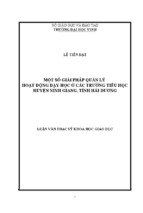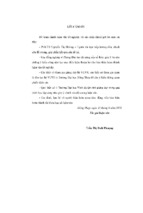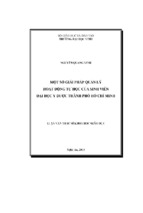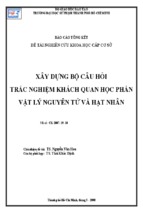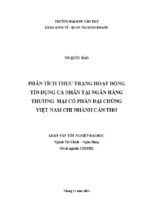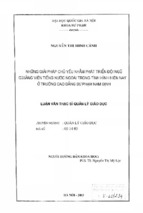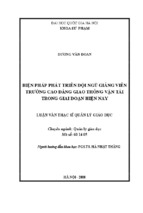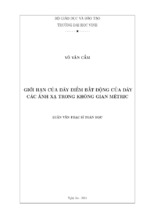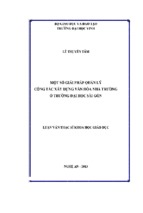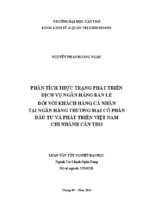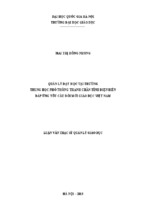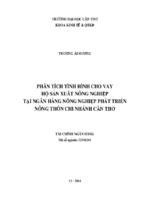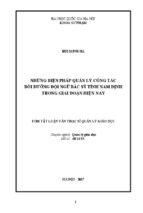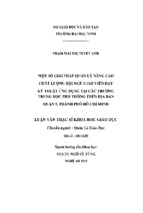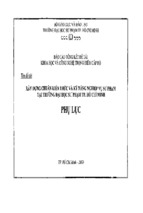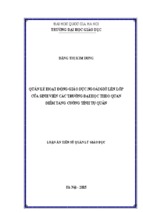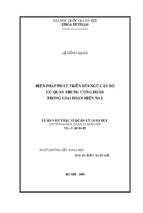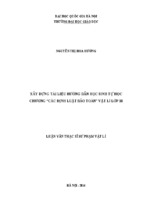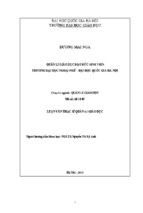HO CHI MINH CITY UNIVERSITY OF PEDAGOGY
FOREIGN LANGUAGE SECTION
ENGLISH
FOR PRESCHOOL EDUCATION
BOOK 2
COMPILED BY
NGUYEN THUY OANH –MA.
NGUYEN THI BICH THUY –MA.
HoChiMinh City 2003
1
Preface
The aim of this book is to help both the students who are
studying in Department of Preschool Education and those who are
interested in children.
We would like to thank the Department of Preschool Education
and all those whose sources have been used in this book.
We are grateful too, to teachers, colleagues and students for
their guidance in the preparation of this book.
During the compiling of this book, there are certainly short
comings we are ourselves responsible for. We hope we will get more
valuable comments and suggestions from the concerned in order to
improve the quality of the book.
Hochiminh City, 2003
Nguyen Thi Bich Thuy
Nguyen Thuy Oanh
2
UNIT 1
AN OUTLINE OF PSYCHOLOGY
OF PRESCHOOL AGE
Pre-reading task
1. Do you like children a lot? Do you understand them quite well?
2. Are you interested in books about child psychology? Why?
3. You are going to read the text about psychology of preschool age. Here are some
concepts you need to know:
a. Small muscle development: Development of dexterity such as cutting with scissors,
using crayons to colour sth.
b. Large muscle development: Development of motor skills such as running or throwing
c. Prosocial behaviours: Actions that show respect and caring for others
Read the text
Children can be termed preschoolers when they are between 3 and 6 years of age. This
is a time of rapid change in all areas of development. Children master most motor skills
by the end of this period and can use physical skills to achieve wide range of goals. By
the age of 6, children use almost completely mature speech, not only to express their
wants and their needs, but also to share their ideas and experiences. Socially, children
appropriate behaviours and rules and become increasingly adept at interacting with
other children.
Physical development describes the changes in the physical appearance of children as
well as in their motor skills. During the preschool years the sequence in which all
children develop motor skills is generally the same, though some children gain skills
faster than others.
The major physical accomplishment for preschoolers is increased control over the large
and small muscles. Small muscle development, sometimes called fine motor activity,
related to movements such as buttoning a shirt or zipping a coat. Large muscle
development is gross motor activities.
By the end of preschool period, most children can easily perform self-help tasks such as
buckling, buttoning, snapping, and zipping. They can go up and down steps with
alternating feet. They can perform fine motor activities such as cutting with scissors and
using crayons to color a predefined area. They also begin learning to write letters and
words.
3
A young child’s social life evolves in relatively predictable ways. The social network
grows from intimate relationship with parents or other guardians to include other family
members, non-related adults, and peers. Social interactions extend from home to
neighborhood and from nursery school or other child-care arrangements to formal
school. Erik Erikson’s theory of personal and social development suggests that during
early childhood, children must resolve the personality crisis of initiative versus guilt.
During the preschool year, peers begin to play an increasingly important role in
children’s social and cognitive development. Children’s relations with their peers differ
in several ways from their interactions with adults. Peers play allows children to
interact with other individuals whose level of development is similar to their own.
When peers have disputes among themselves, they must make concessions and must
cooperate in resolving them if the play is to continue; unlike in adult-child disputes, in a
peer dispute no one can claim to have ultimate authority. Peer conflicts also let children
see that others have thoughts, feelings, and viewpoints that are different from their
own. Conflicts also heighten children’s sensitivity to the effects of their behavior on
others. In this way, peer relationships help young children to overcome the
egocentrism.
Research involving children who are socially rejected by their peers suggests that these
children are likely to lack positive prosocial skills. Prosocial behaviours are voluntary
actions toward others such as caring, sharing, comforting, and cooperation. Several
factors seem to be associated with the development of prosocial behaviours. These
include the following:
Parental disciplinary techniques that stress the consequences of the child’s
behavior for others and that are applied within a warm, responsive parent-child
relationship.
Contact with adults who indicate they expect concern for others, who let
children know that aggressive solutions to problems are unacceptable, and who
provide acceptable alternatives .
Contact with adults who attribute positive characteristics to children when they
do well.
Comprehension check
1. Circle the main idea of the reading
a. Peer relationships and prosocial behaviour
b. Physical development in early childhood
c. Children’s development during the preschool years
d. Socioemotional development
2. Which one is true in the text?
A major accomplishment for preschoolers is
a. hypothetical thought.
4
b. deductive thinking
c. puberty.
d. increased control over the large and small muscles.
3. Answer the following questions
1. What is term preschoolers defined?
2. At what age can children use most completely mature speech to express what
they want and need?
3. What is physical development?
4. What can children do by the end of the preschool period?
5. What does Erik Erikson suggest?
6. Do children make friends easily when playing together? Why?
7. What do peer relationships help preschoolers to do?
8. Are prosocial behaviors compulsory? Why or Why not?
9. What factors are associated with the development of prosocial behaviours?
Vocabulary
1. Fill in the blanks with the words that appeared in the text.
a. _____________ is an important element in children’s development by the end of
preschool period.
b. Parents not only pay attention to child _____________ development, but also his
emotional development.
c. In general, attending kindergarten in the United States is __________. However,
in some states it is compulsory.
d. Teachers usually deal with children of particular age. For example, a
___________ teacher needs to know what preschool children are like.
Elementary teachers are concerned with middle childhood.
2. Put the words from the box into the gaps:
peers effect
emotional negative
important
preschool social
Although academics may becoming increasingly more (1) ___________, research
shows that social skills are what most (2) ___________ school adjustment. (3)
____________ teachers should not feel pressured into teaching academics beyond what
is developmentally “best practice” but should continue to focus on social and (4)
______________ development. Children who have been rejected by their (5)
___________ in kindergarten tend to have poor school performance, more absences,
and (6) ______________ attitudes towards school that last throughout their school
years. “Three particular (7) _________skills that are known to influence children’s peer
acceptance: play behavior, ability to enter play groups, and communication skills”.
Grammar review
5
1. Form
Talking about ability: can, could, be able to
can
could
+ bare infinitive
be able to
By the end of preschool period, most children can easily perform
self-help tasks.
2. Use
z Can is used to talk about the ability to do something.
- At the age of four the child can identify by pointing to or
matching all major visible parts of the body.
- Where’s the City’s Kindergarten? I can’t find it.
In questions using can, we do not use do, but we reserve the order of can and the
subject.
z Could is the past tense of can to say that someone had a general ability in the
past.
When I was young, I could play tennis.
Before this year, I couldn’t swim.
Note: We do not use could to talk about individual situations. For individual situations
we have to use was / were able to:
He could speak French. When he got lost in Paris he was able to
ask for direction.
He couldn’t sleep because he had insomnia.
z Can and could do not have other forms such as infinitives or participles. If we
need to use these forms, we must use be able to instead of can and could:
I might be able to tell you about one of the benefits of preschool.
They have been able to tell us about the standard of normal
development for children.
Practice
A. Complete these sentences using can, can’t, could or couldn’t and the verb in
brackets. Follow the example.
(sing and
1. I am a student of Department of Preschool Education. I
can
dance) well.
2. My son is two years old. He ____________ (talk) names of ten to fifteen objects
and has a small noun-verb vocabulary.
3. When I was five years old I ________________ (read) short story.
4. He _________ (read) this English book. He hasn’t studied English before.
5. She ________________ (drive) until she went for lessons last year.
6
6. My daughter is very clever, so she _________ (read and write) when she was
four.
7. My child _____________ (dance) beautifully.
8. My father is slightly deaf. He _____________ (hear) very well.
B. Jane and Joan are friends but each one always wants to be better than the other at
every thing. Complete their conversation using can, could, or be able to. Follow the
example.
read when I was only four years old.
1. Jane: I could
Joan: Well, I ____________ read when I was three!
2. Jane: I ______________ speak three languages.
Joan: That’s nothing! I ___________ speak five languages.
3. Jane: Last week, with my savings, I ____________ buy myself a pony.
Joan: Really? Well, last week I ___________ buy a racing horse.
4. Jane: The garden of my house is so big that I ___________ walk to the
end of it.
Joan: That sounds rather small. The garden of my house is so big that I
___________ drive to the end of it in a car.
5. Jane: I ___________ play the piano and the violin.
Joan: Is that all? I ____________ play the piano, the violin, the flute and
the trumpet.
6. Jane: When I was at school I ___________ read the whole book in a day.
Joan: How slow. When I was at high school I __________ write a whole
book in a day.
7. Jane: Last year, I got some many presents on my birthday that I
____________ fit them all in one room.
Joan: What a shame. Last year I got so many presents on my
birthday that I _____ fit them all in my house – I had to rent
the house next door too!
8. Jane: I’m very fit. I _____________ run a mile in less than four minutes.
Joan: Well, I ____________ run a mile in less than four minutes –
back wards!
Discussion
1. Work in groups to decide the motor development of preschool children. Match the
words in A with the clauses in B
A (age)
a. 2-years-olds
b. 3-year-olds
B (skills)
1. Keep leg closer together when walking and running.
Can run and move more smoothly. Reach for objects with
one hand.
2. Can walk a balance beam. Skip smoothly: stand on one
7
c. 4-year-olds
d. 5-year-olds
foot. Can manage buttons and zippers: may tie shoelaces.
Use tools correctly.
3. Can vary rhythm of running. Skip awkwardly; jump.
Have greater strength, endurance and coordination. Draw
shapes and simple figures; make paintings; use block for
buildings.
4. Walk with wide stance and body sway. Can climb,
push, pull, run, hang by both hands. Have little
endurance. Reach for objects with two hands.
2. What age range can each of these words be used for?
kid
1_ 12
infant
…….
child
…….
adolescent …….
girl
.……
woman
……
young person ……
middle-aged person …..
baby
……
teenager
……
boy
……
man
……
young adult
……
elderly person ……
Work in pairs to compare your ideas with your partners
Example: A: I think a kid is between the ages of 1 and 12.
B: I think a kid can be between 1 and 17.
Listening
Listen to people talking about how they feel. Tick the best response.
1. __ Oh, that’s good.
5. __ Why not?
__ Oh, that’s a pity.
__ What’s the matter?
2. __ Oh, that’s great.
6. __ Oh, good.
__ Oh, that’s too bad.
__ What a pity!
3. __ Why did he do that?
7. __ What did you do?
__ How did he do that?
__ Why don’t you take
4. __ How do you feel?
something for it?
__ Have you taken anything for it?
Writing
Put the words and phrases in the right order to make sentences
1./ teacher / maintain / the interest / must / of children / and / the growth /.
________________________________________________________________
2./ there is / strong connection / the sense of smell / between / and / the sense of taste /.
________________________________________________________________
________________________________________________________________
3./ the children / tend / more slowly / to sing / in a lower voice /.
________________________________________________________________
4. / the child / is shown / how to observe / from all sides / objects /.
8
________________________________________________________________
5./ the classroom / must / fully decorated / be /.
________________________________________________________________
6./ the children / feel / when / together / happy / play / they /.
________________________________________________________________
Translation
1. Translate into Vietnamese
What kind of early childhood education programs exist?
Economic and social factors have led to an increasing demand for early childhood
education programs, including day-care centers, nursery schools, compensatory
preschool programs, and kindergarten. Research findings have tended to support trends
toward early intervention, school-readiness training, continuation of compensatory
programs in the early elementary grades, targeting of students who are at risk, and
avoidance of the potential drawbacks of kindergarten retention.
2. Translate into English
ÔÛ Anh khi treû em leân hai hoaëc ba thöôøng hoïc ôû tröôøng maàm non, nôi chuùng hoïc caùc troø
chôi vaø caùc baøi haùt ñôn giaûn. Tröôøng hoïc thöïc söï cuûa chuùng chính laø tröôøng tieåu hoïc.
9
UNIT 2
LEARNING ABOUT CLASSROOM STYLES
Pre-reading task
Answer the following questions
1. Have you ever visited any kindergartens?
2. What can you observe from that?
Read the text
In collaborating with kindergarten teachers, preschool teachers and parents need to
visit the school and pay close attention to details that may affect their students in
kindergarten. Maxwell confirmed that when teachers and parents agree on a
philosophy of education, children usually adjust more easily. Children feel more secure
in their new environment if they feel that their parents support the teacher and the
school.
The first step may be either a meeting with the kindergarten teacher or a class field trip
to the elementary school. “Observe kindergarten classroom to identify teaching styles,
classroom management techniques, and routines. Also try to identify skills that are
needed to be successful in participating in the kindergarten classroom.”
In her research, Karr-Jelinek used a checklist of what parents and teachers should look
for in a kindergarten classroom, to see if their children – both normally developing and
with special needs – are ready for the classroom they visit:
How many steps are given at a time in directions?
What types of words are children expected to understand?
How does each individual child compare to the other children?
How long are children expected to sit still in a group?
How often do children speak out of turn or move around when they should be
sitting?
How much independence is expected?
What type of work is being done? (small groups, seatwork, etc.)
Where might my special needs students need extra help?
What kind of special information can I pass along to the teacher about each
child?
Although expectations vary by teacher and school district, by the time children
reach kindergarten they should be able to listen to a story in a group, follow two
10
or three or three oral directions, take turns and share, follow rules, respect the
property of others, and work within time and space constraints. They need to
learn the difference between work and place, knowing when and where each is
appropriate. “Most five-years-olds can express themselves fluently with a
variety of words and can understand an even larger variety of words used in
conversations and stories”.
Many kindergartens make use of learning centers, small group instruction, and whole
group language activities. However, others use “structured, whole group paper-andpencil activities oriented to academic subjects, such as reading and mathematics. The
curriculum in these kindergartens often constitutes a downward extension of the
primary grade curriculum and may call for the use of workbooks, which are part of a
primary level textbook series. Many early childhood professionals have spoken out on
the inappropriateness of such a curriculum.
Comprehension check
Answer the following questions:
1. What do preschool teachers and parents need to do in collaborating with the
kindergarten teachers?
2. When do children usually adjust more easily?
3. How do children feel if their parents support the teacher and the school?
4. What is the first step in collaborating with kindergarten teachers?
5. What should they be taught by the time the children reach kindergarten?
6. What can five-year-old students do?
7. Why have many early childhood professionals spoke out on the
inappropriateness of a curriculum?
Vocabulary
1. Match a word in the column A with its definition in the column B and make
sentences with these words
A
1. style
2. field trip
3. routine
4. collaborate
5. curriculum
6. adjust
B
a. to work together
b. become or make sb/sth suited to new condition;
adapt oneself
c. a trip away from the classroom to permit the
gathering of data at first hand
d. the way in which anything is made or done
e. a fixed and regular way of doing things
f. the subjects taught at a particular school, college
11
2. Complete the sentences with the above words
a. Every year kindergartens take ______________ for students to the zoo, park…to
observe animals, plants.
b. Play at the center of the _____________ integrates science as language, mathematics
and social studies.
c. There is much more freedom for women in Britain. It’s sometimes difficult for
Japanese women to _____________.
d. Preschool teachers may ___________ regularly with parents in educating children.
e. Now my guest’s left. It’ll be back to the old ___________.
f. Preschool teachers with their knowledge of different learning __________ and the
temperaments of their students, can help children with the transition.
Grammar review
Talking about probability and possibility: may, might
1. Form:
may
might (not) + V
Note: might = perhaps will
2. Use
May, might are used to talk about the chance, or possibility, of future situation:
When I grow up I may be a sociologist or I might be primary teacher.
I may go to the conference on rating scales for children in day-care tonight (It is
possible that I will go).
What are you doing next year? I might join a course in English (Perhaps I will
join)
May is less certain than will.
Vietnam might win the match. (It’s possible, but I don’t know.)
Vietnam will win the match. ( I am sure they will.)
Practice
A. This time you have to talk about possible happenings. Use the words in brackets.
Example: Do you think it will rain this afternoon? (may)
Æ It may rain this afternoon.
1. Do you think Tom will be late? (may)
_____________________________________________________________.
2. Do you think Ann will come to the party? (might not)
_____________________________________________________________.
3. Do you think Ann will be able to find our house? (might not)
_____________________________________________________________.
4. Do you think there’ll be a new school this year? (might)
_____________________________________________________________.
5. Do you think Tom will pass the exam? (may not)
12
_____________________________________________________________.
6. Do you think it’ll snow later? (may)
_____________________________________________________________.
7. Do you think she’ll go out with you? (may)
_____________________________________________________________.
B. Underline the correct verb form in the following sentences
1. Don’t wait for me. I’ll be/ I might be late. It depends on the traffic.
2. ‘What are you doing tonight?’
‘I don’t know. I’m going/ I might go out or I’m staying/ I might stay at home.
3. We have guests coming for Sunday lunch. I’m going to cook/ I might cook roast beef
and Yorkshire pudding. I’ve bought all ingredients.
4. ‘I’m going to buy George a pink shirt.’
‘ I wouldn’t, if I were you.’
‘Why not?’
‘He isn’t going to like/ He might not like the colour pink.’
5. Take an umbrella with you when you go out. It’ll / might rain later.
6. Catherine wants to be a politician. Who knows? One day she’ll be/ she might be
Prime Minister!
What do you think?
Talk about the kindergarten you have visited. Use the prompts below to help you.
- It location
- Kinds of building structures
- Peers and their teachers
- What should be done to make it a better place for children to study.
Listening
You will hear people talking about things they like and don’t like doing in their
spare time. Listen and tick how much they like each activities
Likes it a lot
Likes it a little
Doesn’t like it at all
1. playing cards
2. playing sports
3. going to parties
4. eating out
5. dancing
6. watching TV
7. listening to music
8. cooking
Writing
Fill each of the numbered blanks in the following passage. Use only one suitable word
in each space.
13
Communication plays a vital (1) _________ in young children’s lives. From a friendly
smiles (2) ________ a handshake to a skipping movement to a majestic painting or a
peppy tune, expression – in all (3) _________ forms – surrounds and influences
children every day. Communication contains a lot (4) _______ activities. Reading,
language arts, music, art, movement, physical education, social studies, and science (5)
________ all presented in the activities. Children delight in the creative forms of
expression found in herein, including painting to musical moods, pantomiming career
aspirations. Open communication is natural (6) _________ young children. Children’s
expression, in a variety (7) _______ forms, abound.
Translation
A. Translate the poem into Vietnamese
Kindergarten Here We Come
Kindergarten, Here We Come!
Send your little ones on their way with these songs!
(sung to the tune of “Twinkle, Twinkle, Little Star”)
Kindergarten, here we come!
We know we’ll have lots of fun.
Lots of things to make and do.
Reading, writing, counting, too.
Kindergarten, here we come!
We know we’ll have lots of fun.
14
UNIT 3
PSYCHOLOGICAL BACKGROUND
OF CLASSIFICATION ACTIVITIES
Pre-reading questions
1. Match a noun on the left with a definition on the right
1. object
a. special quality or characteristic
2. property
b. expert in psychology
3. item
c. group of object used together
4. set
d. single article or unit in a list
5. psychologist
e. solid thing that can be seen and touch
2. Fill in the blanks with the words in exercise 1 to complete the sentences.
a. She’s just been to the supermarket. She’s checking some ________ in the shopping
list.
b. Vygotsky is the well-known child _____________ all over the world.
c. There are several _____________ on the floor of the room: toy car, bowl…
d. There is a _________ of four dinning chairs in the kitchen.
e. The child learn to identify objects, to recognize their various __________.
Read the text
The psychologists Piaget and Vygotsky trace the child’s tendency to classify back to his
early years. The baby learns from experience which objects can or can not be put into
his mouth; which objects can or cannot be held in his hand; which subjects do or do not
produce noise when moved; he learns to distinguish between breakable and
unbreakable objects. All these are processes which concern the characteristics of
objects. The child absorbs this information by performing various actions with objects
and observing the results which will determine his attitude towards them. However, he
is not able as yet to establish a relationship between the objects. When two or threeyear-old child is asked to collect objects that are similar in some ways, he usually
places together objects with no connection whatsoever. The child tends to fuse in his
perception very distant items because of some casual impression.
Later, the child will be able to group various objects together, not only because of
casual subjective impressions, but also because of connection actually existing between
those objects.
In the next stage of his development the child combines objects into sets according
patterns from his practical experience. For example, the combination of objects on the
basis of their common functional operation: knife, fork and spoon, or a set of clothes.
15
Only at the older age the child is able to isolate properties from objects and collect
objects with similar properties. To do this he must concentrate on certain properties of
the objects while ignoring those which are irrelevant.
At five to six years of age, the child is able to classify objects according to their similar
properties. He begins to understand why he has grouped certain objects together and he
can use this knowledge to classify the remaining objects. Moreover, he can reclassify
the same group of objects according different criteria. At kindergarten age, the child
begins to internalize concepts related to classification. The most important point of all
these activities is not the linguistic aspect but, first and foremost, the ability of the child
to classify, which is expressed in his actual action.
The concept of set must be perceived by the children intuitively, the relation starting
from the children’s social life: their names, toys…The classification activities are based
mainly on classification of concrete objects which offer a large number of stimulation.
These are accompanied by the classification of pictures, objects and abstract forms
(letters and numerals).
The classification methods suggested are:
Guided classification – where the task is specified and suggested by the teacher.
Free Classification – whereby the objects are presented to the child and he chooses a
particular property or properties as the criteria for forming the groups or dividing groups
into subgroups.
Comprehension check
Are these sentences true (T) or false (F)?
1. ___ A child has his tendency to classify back to his early years.
2. ___ The baby learns from his / her parents’ experience of all kinds.
3. ___ These processes concern the characteristics of objects around the baby.
4. ___ Child can perform various actions with objects but can’t observe the result.
5. ___ A child can’t set up a relationship between the objects.
6. ___ A child can place together the same objects that he’s asked to collect
because of their impression available.
7. ___ The child then will be able to group various objects together because of
some casual expressions and the connection of the object.
8. ___ In the next stage of his development the child can isolate properties from
object.
9. ___ At the older age the child just can collect objects with different properties.
10. ___ The child begins to understand why he has groups the objects of the objects
at the age of four.
11. ___ The ability of child to classify objects is expressed in his / her actual action.
12. ___ The child’s classification activities are based mainly on classification of any
object.
13. ___ In the guided classification the teacher’s task is suggested.
14. ___ The child can choose a particular property that is presented to him.
Vocabulary
16
1. Write the related verbs and nouns
Example:
oppose (v) Æ opposition (n)
a. classify
b. characterize
c. isolate
d. stimulate
e. combine
f. connect
2. Put the words in the correct gaps
positional expressions, children actions, vertical fashion, environment, young children,
construct, activities(2),
Building and constructing
Children love to build and make things. This love for building is first seen in (1)
____________ as they make things in a horizontal fashion and later, as older children,
they pile things one on another in a (2) ___________. This love for building is seen
around the (3) _____________ – where ever young children are found. With Legos,
nesting blocks and all types of other things, children build and (4) ___________ the
world in which they play. Constructing carries with it a host of exciting opportunities to
develop, practice, and master various understandings, skills, and attitudes.
The activities include making snowflakes, drawing’s children’s and animals’ bodies,
experiencing (5) ______________, building groups of objects, investigating plant and
animal life forms, understanding word study, obeying safety and danger signs, imitating
the movements of common items found in homes, watching television, and numerous
other (6) __________. The world of building comes alive as children become immersed
in sea of creative things. Through the (7) ____________, they come to know and
understand the world. Building and constructing are, quite simply, fun (8) __________
that become opportunities for learning.
Grammar review
Talking about obligation and necessity 1: must, have to
1. Form
must
+V
have to
Educators must know the principle theories of children’s cognitive,
social, and moral development.
2. Use
z Must and have to are used to talk about something which is necessary. Must
expresses strong obligation from speaker.
I must study hard. I really want to pass this exam.
z Have to expresses strong obligation that comes from a rule or situation that we
have no control over:
I have to clean my teeth every day. My teacher has told me to.
17
z As must does not have any other forms such as an infinitive or participles, we
use have to when these forms are needed:
I don’t finish my report today I might have to work at the weekend.
This game was so difficult that the child had to ask mother for help.
Practice
A. Complete these sentences using must when possible, or have to
1. My child’s toy car was stolen, so I have to get another one for him.
2. The law says that every one _____________ wear a seat belt when they are
traveling by car.
3. You _____________ call me as soon as you arrive.
4. I like to sleep late, but I _________ start work at 8 a.m. every morning.
5. I don’t like my hair. I _______________ have it cut soon.
6. The doctor says my baby _____________ stay in bed today.
7. You _________ be back home before it gets dark or I will be worried.
8. I feel terrible. I _____________ sit down.
B. Complete these sentences using the correct form of have to
1.
2.
3.
4.
5.
6.
7.
8.
When the telephone rang I __________ get out of the bath to answer it.
I expect I _____________ get a part-time job next year.
Our television broke down last week, so we _______ buy a new one.
My parents have been on holiday for two weeks, so I ____________look after
their dog.
If you fail the exam, you _____________sit it again next year.
You ___________ stay in bed for a week until you feel better.
Since Harold got his new job, he _____________ work every weekend.
I ______________ wait for an hour in the supermarket last week.
Necessity/obligation 2 : mustn’t, don’t have to, needn’t(have), didn’t need to, don’t
need to, doesn’t need to
Use
1. Don’t have to, don’t need to or needn’t expresses absence of obligation.
Mustn’t is used to express a prohibition.
You mustn’t make noise. The baby is sleeping.
You don’t have to feed the child. I’ll do that.
Children don’t need to swim in the sea. They have a swimming pool.
2. Needn’t have and didn’t need to are used to talk about necessity and obligation in
the past. Needn’t have with a past participle is used to talk about an action which
someone did, although it was unnecessary.
I took my swimsuit to the beach. I needn’t have taken it. It was too
cold to swim.
18
3. Didn’t need to with an infinitive is used to talk about an action which was
unnecessary.
Peter didn’t need to go to kindergarten on Saturday.
(We don’t know if he need to go or not.).
Practice
A complete these sentences with the correct words from the brackets. Follow the
example:
1. Children mustn’t
swim in the sea. It’s dangerous.
(mustn’t, needn’t)
2. child at the age of two_______________ to count blocks. He only looks for
coordinated hand movements and use fairly big blocks.
(mustn’t. doesn’t have to)
3. Peter is pleased as he _______________ go to kindergarten tomorrow.
(mustn’t doesn’t need to)
4. Andy ________________ go inside that old building. It is not safe.
(mustn’t, needn’t)
5. You ________________ drink the water in the river. It is not clean.
(mustn’t, don’t need to)
6. You _______________drink the water in the river. I have brought some
lemonade!
(mustn’t, don’t need to)
7. I ________________ walk to work as I have borrowed my sister’s car this week.
(mustn’t, needn’t)
8. The doctor says I ________________ walk for a few days as I have hurt my
ankle.
(mustn’t, don’t have to)
B. Mary and June are getting ready to go on holiday. They are planning what to take
with them. Complete their conversation using the words in the box. Follow the
example:
mustn’t needn’t have
needn’t
mustn’t needn’t have
didn’t need to
don’t have to don’t need to
1. Mary: Should I take any warm clothes?
any warm clothes – it will be hot.
June: You needn’t
2. Mary: I bought a new camera for the holiday.
June: You _______________ bought a camera – you could
have borrowed my brother’s one.
3. Mary: That’s OK. I wanted a new one anyway.
June: Remember, you _______________ pack your new camera at the
Bottom of your bag – it will get broken there.
4. Mary: OK. Shall I take my hair dryer?
June: You _______________ take your hair dryer – I’ll take mine and
19
we don’t need two.
5. Mary: Do you have a book to read?
June: I nearly bought a book but then my dad gave me one of his so I
_________________ buy one.
6. Mary: That was lucky. I’ve got three big books to read.
June: You _______________ take lost of heavy things or your luggage
will weigh too much.
7. Mary: Yes, you’re right. I must remember my passport this time.
June: You _________________ remember your passport. We aren’t
going to a foreign country.
8. Mary: Of course. I have brought my sea- sickness tablets too.
June: You ____________ brought them either – we’re not
traveling by boat!
Discussion
Work in groups to discuss the questions below.
- Should children be encouraged to perform classification activities, then explain
what they did and why?
- What objects that may be classified can be put in a variety of receptacles or in
certain places?
Listening
You will listen to the sentences containing one of the words in each pair below. Circle
the word you hear.
1. toes nose
5. throat
foot
2. neck
back
6. wrist
chest
3. hips lips
7. eyes
cars
4. hair ear
8. leg
neck
Writing
Use the following sets of words and phrases to write complete sentences.
1. / the children / speak directly / peers / attentive to others / the group /.
____________________________________________________________
2. / the child / learn/ about materials (key, shoes…)/ observation / by working / the
objects /..
____________________________________________________________
____________________________________________________________
3. / it / essential / that / child / the same / educational opportunities /.
____________________________________________________________
4. / children / should / go / bed / early /.
____________________________________________________________
5. / Parents / afraid / their children / will / misbehave / and / get / trouble /.
____________________________________________________________
20
- Xem thêm -

